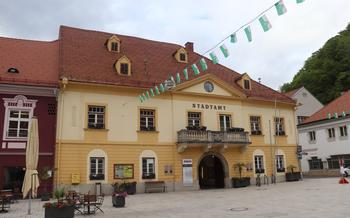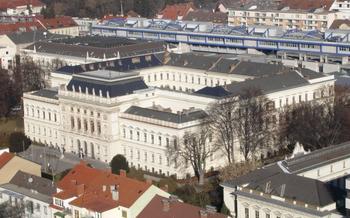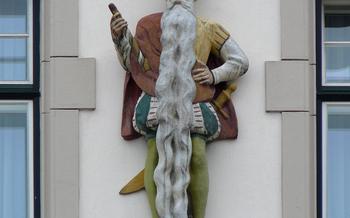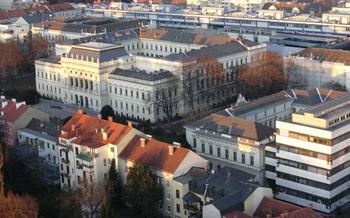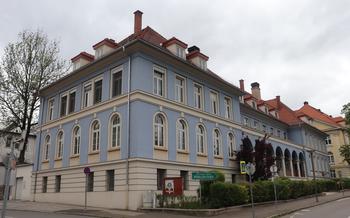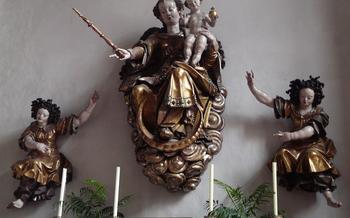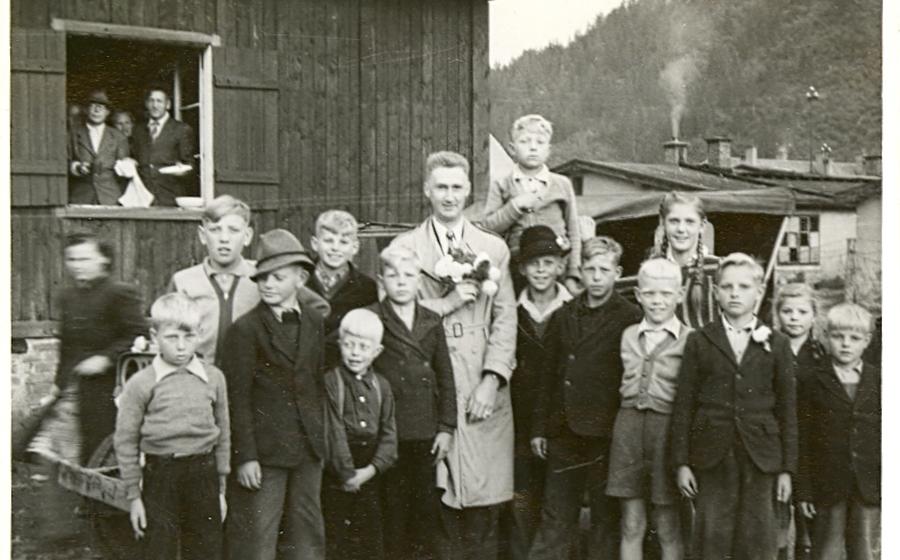
Rein Abbey
- Explore the Rich History of Rein Abbey
- Architectural Marvel
- Art and Frescoes
- Museum and Exhibits
- Guided Tours
- Nature and Surroundings
- Pilgrimage Site
- Local Cuisine:
- Souvenirs and Local Crafts
- Accessibility and Transportation
- Accommodation and Nearby Attractions
- Photography and Social Media: Sharing the Beauty of Rein Abbey
- Respectful Etiquette
- Insider Tip: Experience the Abbey's Charm with an Overnight Stay
Explore the Rich History of Rein Abbey
Founded in 1129, Rein Abbey stands as a testament to the enduring legacy of the Cistercian order in Austria. As one of the oldest and most prominent Cistercian monasteries in the country, Rein Abbey played a pivotal role in the spiritual and cultural development of the region. Its strategic location along the Mur River allowed it to flourish as a center of learning, commerce, and religious influence.
Over the centuries, Rein Abbey has witnessed the rise and fall of empires, the ebb and flow of religious and political movements, and the patronage of powerful figures like the Habsburg dynasty. The abbey's close ties to the Habsburgs brought wealth, prestige, and architectural enhancements, transforming it into a symbol of both religious devotion and aristocratic power.
Today, Rein Abbey stands as a living testament to its rich history, inviting visitors to delve into the fascinating stories and personalities that have shaped its existence.
Architectural Marvel
Rein Abbey stands as a testament to the architectural prowess of the Romanesque and Gothic periods. Its church, a masterpiece of design, boasts a stunning blend of these two styles. The exterior facade captivates with its intricate carvings, delicate arches, and towering spires that pierce the sky. Enter the church, and be awed by the grand nave, supported by rows of robust pillars that create a sense of awe and reverence. The vaulted ceilings, adorned with vibrant frescoes, add to the church's majestic ambiance.
Beyond the church, the abbey's cloisters offer a serene sanctuary for contemplation. Each side of the quadrangle features graceful arches supported by slender columns, creating a peaceful oasis. The chapter house, where the monks once gathered, showcases exquisite stained-glass windows that depict biblical scenes in vibrant hues. The refectory, where the monks shared their meals, is a testament to the abbey's commitment to communal living. Its vaulted ceiling and ornate carvings hint at the artistry that permeated every aspect of monastic life.
Throughout the abbey, visitors can trace the evolution of architectural styles as renovations and additions were made over the centuries. From the Romanesque origins to the Gothic embellishments, each era left its mark on Rein Abbey, contributing to its rich architectural tapestry.
Art and Frescoes
The walls and ceilings of Rein Abbey are adorned with breathtaking frescoes that depict religious scenes, historical events, and allegorical figures. These artworks serve as a visual testament to the abbey's rich history and cultural significance.
Created by talented artists during the Middle Ages and Renaissance, the frescoes showcase a range of techniques and styles. From delicate brushstrokes to vibrant colors, each fresco tells a captivating story, inviting visitors to delve into the abbey's past.
One of the most notable frescoes is the "Last Judgment," which adorns the tympanum of the abbey church's main portal. This awe-inspiring depiction of Christ surrounded by angels and saints, along with the righteous and the damned, is a powerful reminder of the consequences of human actions.
Inside the church, visitors can admire the stunning frescoes that grace the vaults and walls of the nave, choir, and transepts. These intricate artworks depict scenes from the life of Christ, the Virgin Mary, and various saints, as well as allegorical representations of virtues and vices.
The vivid colors and expressive figures of the frescoes bring the biblical narratives and moral teachings to life, creating a sense of awe and inspiration for visitors. Each fresco is a masterpiece in its own right, showcasing the artistic talents and deep faith of the monks who created them.
Museum and Exhibits
A treasure trove of history and culture awaits visitors at the onsite museum of Rein Abbey. This captivating space invites you on an immersive journey through the abbey's rich past, showcasing a diverse collection of religious artifacts, manuscripts, and historical documents.
Through interactive exhibits and displays, the museum brings to life the daily life and traditions of the Cistercian monks who once called Rein Abbey home. Explore the fascinating stories behind the abbey's construction, restoration, and significance, gaining a deeper understanding of its enduring legacy.
Among the museum's highlights are intricate liturgical objects, such as chalices, monstrances, and reliquaries, that were meticulously crafted by skilled artisans. These exquisite pieces offer a glimpse into the artistry and devotion that permeated the abbey's religious practices.
Don't miss the opportunity to delve into the world of medieval manuscripts, where beautifully illuminated pages recount tales of faith, history, and philosophy. These precious documents provide a tangible connection to the intellectual pursuits of the monks and the cultural exchange that took place within the abbey's walls.
Rein Abbey's museum is not just a repository of artifacts; it is a gateway to understanding the abbey's role as a spiritual and cultural center throughout centuries. Immerse yourself in the stories and treasures that await, and leave with a newfound appreciation for the enduring significance of this historic institution.
Guided Tours
Embark on a captivating journey through time as you join a guided tour of Rein Abbey. Knowledgeable guides, passionate about the abbey's rich history, will unveil the secrets and stories that lie within its ancient walls. Learn about the construction, restoration, and significance of this architectural masterpiece, gaining insights into the lives of the Cistercian monks who called it home.
As you wander through the abbey's sacred spaces, your guide will bring to life the stories of its past inhabitants, their struggles, and triumphs. Discover the hidden meanings behind the intricate carvings, frescoes, and stained-glass windows that adorn the abbey's interior.
With personalized anecdotes and engaging storytelling, your guide will transport you back in time, allowing you to experience the abbey's history firsthand. Whether you're a history buff, an architecture enthusiast, or simply seeking a deeper connection with this sacred site, a guided tour of Rein Abbey promises an unforgettable and enriching experience.
Nature and Surroundings
Amidst the historic grandeur of Rein Abbey, nature plays a harmonious symphony. Serene gardens and tranquil courtyards grace the abbey grounds, inviting visitors to stroll through a tapestry of colors and scents. The meticulous landscaping showcases the region's rich flora, from vibrant blooms to verdant shrubs, creating a picturesque haven for contemplation and relaxation.
As you wander through these serene spaces, take a moment to discover the local fauna that thrives in this natural oasis. Observe the graceful birds that flit among the trees, their melodies blending with the gentle rustling of leaves. Listen for the cheerful chirping of crickets and the buzzing of bees, adding a touch of vibrancy to the tranquil atmosphere.
From the abbey's vantage point, breathtaking views of the surrounding landscape unfold before your eyes. Rolling hills, lush forests, and shimmering rivers paint a picturesque panorama that will leave you spellbound. Capture the beauty of this serene setting with your camera or simply soak in the tranquility, allowing the natural splendor to rejuvenate your senses.
Pilgrimage Site
Rein Abbey has long been a significant pilgrimage site, attracting devout individuals seeking spiritual renewal and guidance. Its reputation as a sacred destination can be traced back to the Middle Ages when pilgrims flocked to the abbey to venerate the relics of St. Lambert, a 7th-century bishop revered for his piety and miracles. Over the centuries, the abbey's reputation grew, and it became a popular destination for pilgrims from across the region.
Pilgrims would often journey to the abbey on foot, enduring long and arduous treks to reach its sacred grounds. Upon arrival, they would participate in religious ceremonies, offer prayers, and seek blessings from the monks. The abbey's serene atmosphere and spiritual energy provided solace and comfort to weary pilgrims, who found respite and rejuvenation within its walls.
Even today, Rein Abbey continues to be a place of pilgrimage for those seeking spiritual fulfillment. Pilgrims from all walks of life come to the abbey to pray, meditate, and connect with their faith. Whether seeking guidance, solace, or a deeper connection with the divine, pilgrims find solace and inspiration within the abbey's sacred precincts.
Local Cuisine:
A visit to Rein Abbey is not complete without savoring the regional culinary delights influenced by its rich history. The abbey's surroundings are home to fertile lands and skilled farmers, resulting in an abundance of fresh, local ingredients. Indulge in traditional Austrian dishes prepared with passion and expertise, showcasing the flavors and aromas that reflect the region's cultural heritage.
Sample the hearty Wiener Schnitzel, a classic Viennese dish featuring a tender, breaded cutlet served with a tangy potato salad. For a taste of regional specialties, try the Styrian Backhendl, a crispy fried chicken dish often accompanied by refreshing potato-cucumber salad.
Vegetarian and vegan visitors will find plenty of options to satisfy their taste buds. Explore the variety of Käsespätzle, a delectable dish featuring soft egg noodles tossed in melted cheese and onions. Indulge in the flavorsome Schwammerlgulasch, a rich and creamy mushroom stew, or savor the hearty Erdäpfelkäs, a traditional potato and cheese dish.
Pair your meal with a refreshing glass of Austrian wine, renowned for its crisp and fruity flavors. The region is home to several vineyards, offering a diverse selection of white and red wines to complement your culinary journey.
After your meal, treat yourself to a sweet indulgence. Sample the mouthwatering Salzburger Nockerl, a fluffy soufflé-like dessert topped with powdered sugar. For a taste of local tradition, try the Kärntner Reindling, a sweet bread filled with cinnamon, raisins, and nuts, reflecting the region's rich culinary heritage.
Souvenirs and Local Crafts
The gift shop at Rein Abbey is a treasure trove of unique souvenirs and local crafts that capture the spirit of this historic site. Browse the shelves to discover a variety of items inspired by the abbey's architecture, art, and traditions. From intricately carved wooden figurines to delicate ceramic pieces adorned with the abbey's emblem, there's something for every taste and budget.
Support the local artisans and craftsmen by purchasing their creations and take home a piece of Rein Abbey's charm to cherish your visit. Whether it's a hand-painted ornament, a beautifully illustrated book about the abbey's history, or a set of locally made candles, your purchase will not only serve as a reminder of your time here but also contribute to the preservation of the abbey's rich heritage.
Accessibility and Transportation
Reaching Rein Abbey is a breeze, whether you prefer the convenience of public transportation or the freedom of your own vehicle. Trains and buses regularly depart from major cities and towns in Austria, making it easy to plan a day trip or an extended stay. The abbey's central location in Kapfenberg ensures excellent connectivity, with frequent services to and from the city center.
For those who prefer the flexibility of driving, the abbey is easily accessible via well-maintained roads. Ample parking facilities are available on-site, ensuring a hassle-free visit. Visitors with disabilities will find that Rein Abbey is well-equipped to accommodate their needs, with designated parking spaces and wheelchair-accessible routes throughout the grounds.
Accommodation and Nearby Attractions
Complement your visit to Rein Abbey by exploring the charming accommodations in the surrounding area. From cozy guesthouses and bed and breakfasts to modern hotels, there are options to suit every taste and budget. Extend your stay and delve deeper into the region's rich history and culture.
Take advantage of the opportunity to visit nearby attractions that enhance your experience. Explore the picturesque landscapes, quaint villages, and historic landmarks that dot the region. Discover hidden gems and create unforgettable memories as you immerse yourself in the local culture and traditions.
Plan an itinerary that allows you to visit the nearby city of Graz, a UNESCO World Heritage Site renowned for its architectural marvels and vibrant cultural scene. Explore the Eggenberg Palace, stroll through the historic streets, and indulge in the delectable culinary delights offered by the city's many restaurants and cafes.
Make the most of your time in the region by visiting other nearby attractions such as the Riegersburg Castle, the largest castle in Styria, or the Lipizzaner Stud Farm Piber, home to the world-famous Lipizzaner horses. These destinations offer unique experiences that complement your visit to Rein Abbey, providing a comprehensive and enriching exploration of the region's diverse offerings.
Photography and Social Media: Sharing the Beauty of Rein Abbey
Rein Abbey's captivating beauty and rich history make it a popular subject for photography enthusiasts. Capture the stunning architecture, intricate frescoes, and serene gardens through your lens to share with friends, family, and fellow travelers. Utilize social media platforms to connect with a global community of abbey admirers and share your unique perspectives. Follow the abbey's official social media accounts for regular updates, event announcements, and behind-the-scenes glimpses into the abbey's daily life. Share your experiences using relevant hashtags to inspire others to explore this hidden gem. Remember to tag the abbey and use location-based services to help others discover this architectural and cultural treasure.
Respectful Etiquette
When visiting Rein Abbey, it is essential to maintain proper etiquette and behavior to ensure a peaceful and respectful atmosphere for all visitors. Dress appropriately, avoiding revealing or casual attire, as the abbey is a sacred space. Maintain silence in designated areas, such as the church and cloisters, to preserve the tranquility of the environment. Be mindful of other visitors, avoiding loud conversations or disruptive activities that may disturb their contemplation and enjoyment of the abbey's beauty and history. Respect the religious significance of the site by refraining from engaging in activities that may be deemed inappropriate or disrespectful. By observing proper etiquette, you contribute to creating a harmonious and welcoming environment for all visitors to appreciate the spiritual and cultural treasures of Rein Abbey.
Insider Tip: Experience the Abbey's Charm with an Overnight Stay
For a truly immersive experience, consider booking an overnight stay at the abbey's historic guest house. Step back in time as you reside within the abbey walls, surrounded by centuries of history and tranquility. Enjoy the unique opportunity to explore the abbey's grounds and facilities after hours, when the crowds have dispersed. Indulge in the serenity of the surroundings, soak in the ambiance, and connect with the abbey's spiritual essence. This exclusive experience offers a rare glimpse into the life of a Cistercian monk and creates lasting memories that will stay with you long after your visit.
